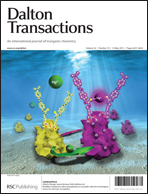Fixed-charge phosphine ligands to explore gas-phase coinage metal-mediated decarboxylation reactions†
Abstract
A combination of multistage mass spectrometry experiments and density functional theory (DFT) calculations were used to examine the decarboxylation reactions of a series of metal carboxylate complexes bearing a fixed-charge phosphine ligand, [(O3SC6H4)(C6H5)2PMIO2CR]− (M = Cu, Ag, Au; R = Me, Et, benzyl, Ph). Collision-induced dissociation (CID) of these complexes using an LTQ linear ion mass spectrometer results in three main classes of reactions being observed: (1) decarboxylation; (2) loss of the phosphine ligand; (3) loss of carboxylic acid. The gas-phase unimolecular chemistry of the resultant decarboxylated organometallic ions, [(O3SC6H4)(C6H5)2PMIR]−, were also explored using CID experiments, and fragment primarily via loss of the phosphine ligand. Energy-resolved CID experiments on [(O3SC6H4)(C6H5)2PMIO2CR]− (M = Cu, Ag, Au; R = Me, Et, benzyl, Ph) using a Q-TOF mass spectrometer were performed to gain a more detailed understanding of the factors influencing coinage metal-catalyzed decarboxylation and DFT calculations on the major fragmentation pathways aided in interpretation of the experimental results. Key findings are that: (1) the energy required for loss of the phosphine ligand follows the order Ag < Cu < Au; (2) the ease of decarboxylation of the coordinated RCO2 groups follows the order of R: Ph < PhCH2 < Me < Et; (3) in general, copper is best at facilitating decarboxylation, followed by gold then silver. The one exception to this trend is when R = Ph and M = Au which has the highest overall propensity for decarboxylation. The influence of the phosphine ligand on decarboxylation is also considered in comparison with previous studies on metal carboxylates that do not contain a phosphine ligand.


 Please wait while we load your content...
Please wait while we load your content...